Another Home Guard Downs locality!
Posted: 26 September 2009 19:55
I spent a fantastic day hunting down a Home Guard locality, finding some slit trenches and some rare weapon pits.
Note: I now no longer believe this to be a Home Guard locality; read the update.
My heart sank a little when I first looked at the map to plan today's excursion; the grid reference I had found in a defence scheme was slap bang in a patch of woodland. There's all sorts of problems with working in woods; leaves cover everything, dense undergrowth hinders movement and confounds GPS receivers, while the holes left by uprooted trees can be easily mistaken for slit trenches. Poor light (even on a sunny day like today) means I occasionally had to use flash when taking photographs.
I set out along a path along the edge of a steep slope and it wasn't long before I chanced upon what I thought might be a pair of slit trenches. The first trench I'm not sure about, as instead of two earthworks, they may originally have been a single position. The photo below shows the second trench, with a telegraph pole between it and the first trench. This foreign object may have been planted in the trench and filled in, cutting one trench in two; a cable from the pole runs into the trench itself making me think the trench predates the pole. I'll need to come back when the vegetation may be lower to try and work out what's going on. I marked this trench on my GPS twice; the first reading was numbered by the machine as '666', so I recorded it again as '667' and deleted the dodgy number. I'm not normally superstitious...
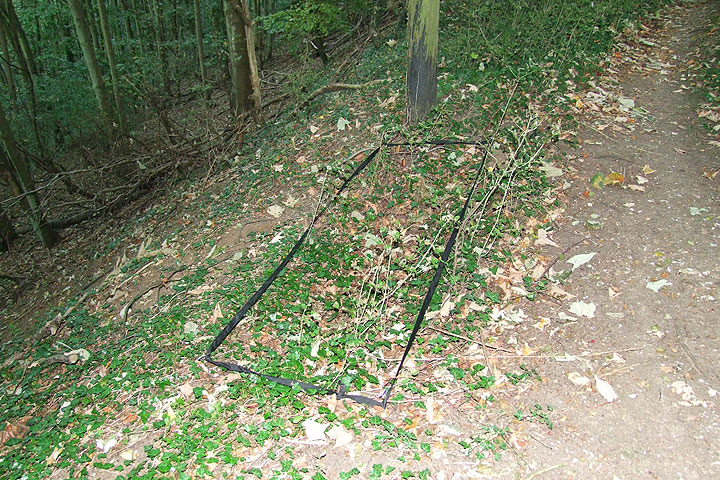
While you're looking at this photo, I've been asked why I sometimes highlight a trench in black and sometimes white, and is this mine tape? The black outline is my patent 'portable slit trench'; this is simply a carefully-measured loop of black webbing with a tent peg knotted into each corner. Because the pegs are set in the right place and the webbing doesn't stretch, by pulling it taut and planting the pegs I have a quick and easy way of defining a 6x2ft (180x60cm) trench! It's black because that's all Woolies were selling in their final week of trading. I have considered striping it with white paint, but I've never had a problem with the black not showing up and the paint would probably flake off when I fold the webbing up anyway.
When I highlight a feature in white I'm using my 30m tape measure - you'll usually see the bright green plastic drum in shot too. I use this for features larger than a slit trench or when the 'portable slit trench' is broken (tangled up in knots or hiding at the bottom of my bag). I have been known to use my 10m yellow metal tape measure to outline trenches, but only if the other methods are in use in the same shot. If there are visibility problems then you may see trenches in my pics highlighted in red, done in Photoshop for clarity. You'll see the white tape measure in action before the end of this post...
Moving about 25m further along the path I struck gold; easily the best find of the day was this pair of buried concrete sewer pipes; these are improvised weapon pits. These are currently the only surviving examples of this method of construction that I know of in East Sussex. I did encounter some many years ago on the Crumbles near Pevensey in support of Type 25 pillboxes, but they were destroyed in the 1990's.

These pipe sections are 5x3ft deep (150cm wide, 90cm deep); the rusting remains of a single angle picket sticking out of the spoil heap to the rear indicated that the area was also wired in.
After a gap of about 130m, the next position was this earthwork; I'm not sure what to make of this though. The red line indicates the base of the spoil heap while the tape measure indicates the inner line of the parapet. I call this a parapet, but this may be better described as a parados, which can be likened to a breastwork built up at the rear of an earthwork. If you consider the direction of fire from this position to be to the right (i.e., down the slope), then the parados is vital to prevent the occupants of this position from being skylined (silhouetted) on the horizon from the point of view of anyone further down the slope.
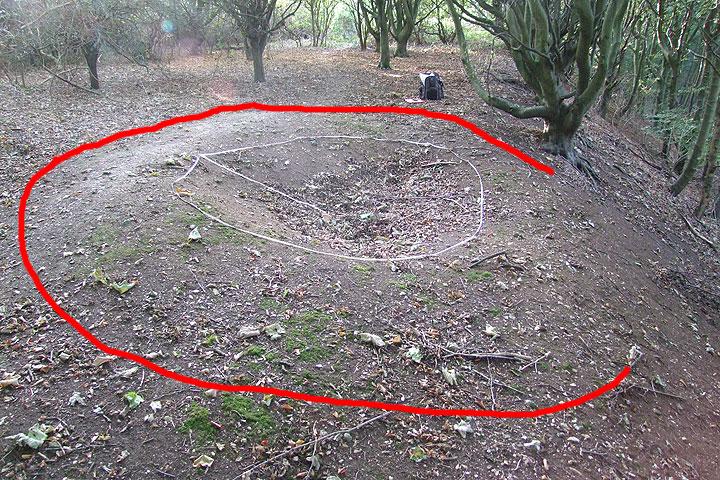
The photo below shows the height of the parados at the rear compared to the parapet at the front; this photo was taken whilst perched in a tree growing further down the slope. My feeling is that a slit trench was dug in the centre of this position.
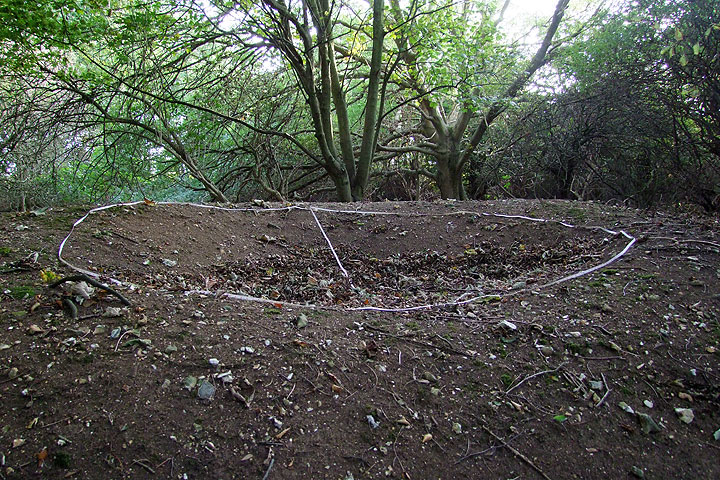
About 45m down the line I encountered another slit trench; this is set at an unusual angle to the others, which are parallel to the ridge line.
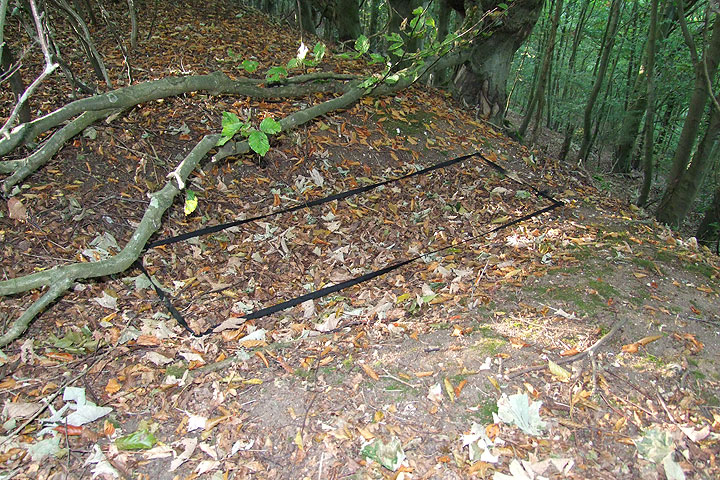
Moving along another 25m I came across this circular position; I don't know if this originally had a concrete sewer pipe in it but the 8-foot diameter would certainly accommodate one and I'm tempted to think this was the case although there is no evidence of concrete here.
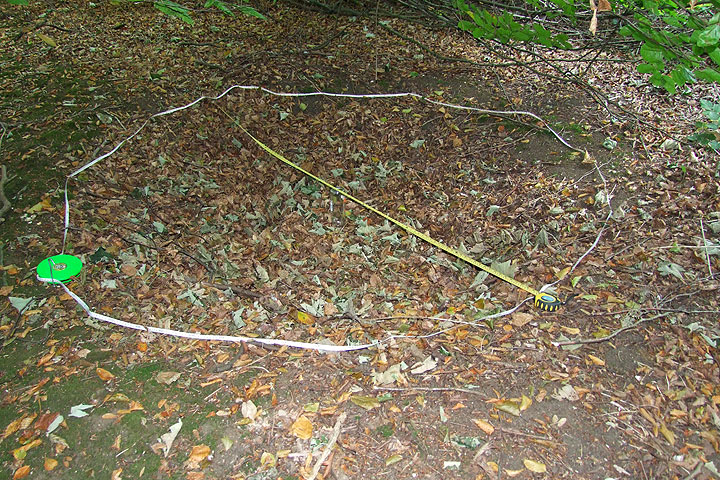
The final site of the day did, however, contain concrete, but only a few small pieces. What we have here is a replica of the pair of concrete sewer pipes previously seen, although largely destroyed.
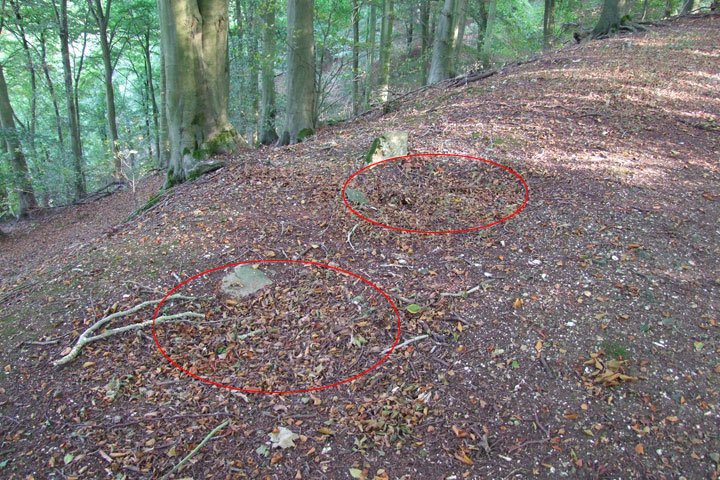
Large pieces of concrete pipe were found about 20m down the slope.
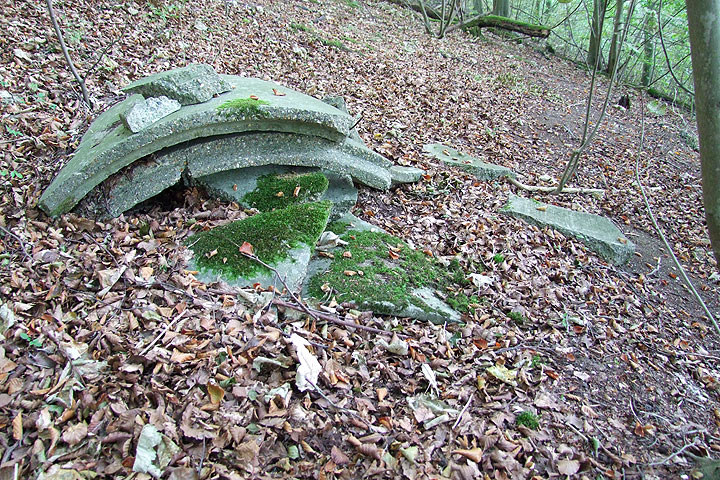
All in all, a fantastic day - documentary research directing fieldwork right on target and some rare surviving examples of defence works identified in a difficult woodland environment - not bad!
- Pete

Email:
Blog Latest

Bishopstone reveals its pillbox secrets
18 October 2021

Pillbox or Observation Post?
10 June 2020

Uncovering the hidden secrets of a pillbox
8 June 2019

Review of 2018
31 December 2018

Wartime Christmas in East Sussex (2)
24 December 2018
Jargon-buster
Angle picket
Iron stake made in several lengths used for construction of barbed wire obstacles or to hold trench revetment in place.
Defence scheme
A military plan of defence for a specified area. Defence Schemes were issued at numerous levels. Defence Schemes were later known as Plans to Defeat Invasion on the orders of General Montgomery.
Pillbox
Generic term for a hardened field defensive structure usually constructed from concrete and/or masonry. Pillboxes were built in numerous types and variants depending on location and role.
Slit trench
Small, narrow trench designed to provide protection against shrapnel and other battlefield hazards. Technically distinct from a weapon pit (which was intended soley as a defensive position) slit trenches were also used as defence works.
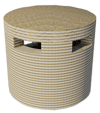
Type 25 pillbox
A small circular pillbox, usually cast in concrete shuttered with corrugated iron. Sometimes referred to as an Armco pillbox after its manufacturer.
This site is copyright © Peter Hibbs 2006 - 2024. All rights reserved.
Hibbs, Peter Another Home Guard Downs locality! (2024) Available at: http://www.pillbox.org.uk/blog/216640/ Accessed: 25 April 2024
The information on this website is intended solely to describe the ongoing research activity of The Defence of East Sussex Project; it is not comprehensive or properly presented. It is therefore NOT suitable as a basis for producing derivative works or surveys!